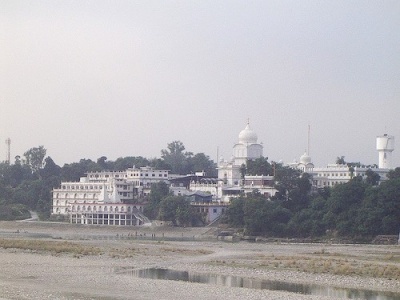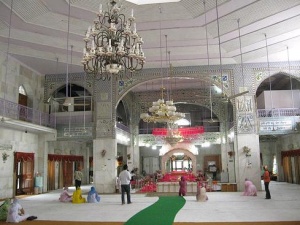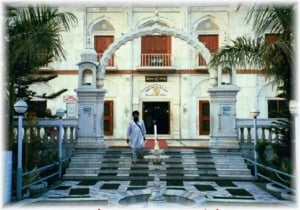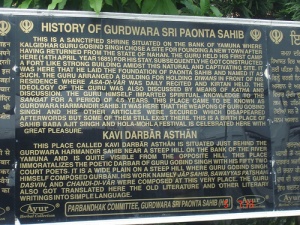Gurdwara Paonta Sahib
Please do not alter as it is currently being revised. If after this is completed please if not improved kindly revert. Tues Sept. 16, 2008
Gurdwara Paonta Sahib is situated in the city of the same name which grew up around Paonta Sahib. It is part of the district of Sirmour, in the state of Himachal Pardesh, India.
History
Gurdwara Paonta Sahib is situated at the place where 16 year old Guru Gobind Singh dismounted his horse to first touch foot in the Kingdom of Sirmour. The Guru had been invited by Raja Medini Prakash the ruler of Sirmour to visit his kingdom. The Raja, as many other stories relate, was very hopeful of establishing a strong relationship with the powerful Sikh Guru. As a special gesture of respect, the Raja, members of his court and his city's leading merchants had left the security of his palace in the Kingdom's capital - Nathan to greet his guest and his large party of Sikhs. It was much safer in such dangerous times; one of the neighboring Rajas had just taken control of part of his Kingdom and them there was the matter roving bands of Moghul soldiers to worry about as well. It would have been easier to just stay in the safety of one's own Palace or fort waiting for guests to arrive, but the special greeting was meant to make sure that the Guru and his Sikhs felt especially welcomed. The warm welcome apparently had the desired effect for Guru Gobind Singh would spend the next four years at Poanta and leave a written account in which he described his time at Poanta Sahib as the happiest years of his life.
Poanta Sahib was built on the bank of the Yamuna River. It began as a fortlike home for the Guru and his family and ended up being a fortress with a Gurdwara in its interior. The fort was built in record time with the Raja's men aiding the Guru's Sikhs. Some have suggested that the builders were filled with extra energy as the wanted to finish the Guru's new home before his approaching birthday. At the time the forests that surrounded the site abounded in wildlife of every kind. Here the beloved Guru was able to escape the intrigue, envy and down right hostility of the Rajas of the Kingdoms around, Chakk Nanaki, the city his father Guru Tegh Bahadur had founded.
In these beautiful surroundings the Guru engaged himself not only in hunting and training his warrior Sikhs in the martial arts, but he also spent a great deal of his time in literary activities, composing many works of religious, as well as heroic poetry. He filled his Darbar (court) with as many as 52 of India's most talented poets and writers often from the ancient city of Benares, many of whom he put to work translating ancient classics of India's literature from the Sanscrit of the Priests and Khatris into the then common languages of Braj or Punjabi, the vernacular languages of the people.
Before leaving the area, the Guru and his Sikh army defeated some of the neighboring Hill Chiefs who had, in his own words, 'attacked him for no cause'. Known as the Battle of Bhangani it was the Guru's first battle and the first of his victories. Later he assisted the same leaders in the Battle of Nadaun in which his Sikhs helped route the Mughal force of Alif Khan who had been sent to collect funds 'owed' to the Mughal Emperor Aurangzeb. That historic battle was fought at the site where GURDWARA SHRI KAVI DARBAR SAHIB GURU SAHIB now stands, the very same sight once used for the Guru's famed Kavi Darbars where the noise of the nearby Yamuna River had once caused the poets to complaign to the Guru. It is said that after this, with the blessing of Guru Gobind Singh the once roaring river Yamuna fell silent as it passed the Gurdwara Sahib.
Secure in the shadows of the Himalayas Gurudwara Paonta Sahib stands dedicated to the memory of Guru Gobind Singh. Paonta or Panvta is on the right bank of the Yamuna (depending on which direction one faces). It is connected by road with Yamunanagar (at 65 kilimetres), Nahan (at 42 kilometers), Ambala (120 km) and can also be reached from Dehradun (50 kilometers) away by crossing the river at Paonta ferry. It's About 120 km away from Ambala city. The magic of the lower Himalayas works on the mind of the pilgrims who come here to pay respects to the great Guru. Its outskirts are dotted with gardens, green meadows and tall evergreen trees, which echo the gushing sounds of the Yamuna's waters.
other articles which were added saying the same/will edit
The opportunites were enormous. The Guru wrote, "I enjoyed myself on the banks of Yamuna and saw amusements of different kinds." The Guru took many steps to beautify Paonta and devoted most of his time in composing poetry. He was so much enamoured of poetry that he invited fifty two poets to his court. The pleasant environment and salubrious climate refreshed his mind. Most of the time he spent in reading and writing.
It was founded in 1685 by Guru Gobind Singh, who stayed here upto 1688. During this period he engaged himself not only in hunting and training his warrior Sikhs in the martial arts, but also in literary activities composing many works of religious as well as heroic poetry and patronizing several talented poets and writers whom he employed mostly for translating ancient classics into contemporary Braj or Punjabi. Towards the end of his stay, he also fought and won the first battle of his life against a combination of hill chiefs hostile to him, in his words, 'for no cause'. Before he left for Anandpur Sahib, he appointed Bhai Bishan Singh to look after the fortress-like complex and the Gurdwara within it.
This is the place, where Guru used to hold his court and wrote the major portion of the Dassam Granth. The Guru also built the Paonta Fort. It was built in over hundred acres of land, which housed not only his followers, but as many as 46 famous poets.
The Guru left Paonta Sahib after the battle of Bhangani with Raja Fateh Shah, in which he defeated the errant ruler’s army after thirty days of battle. The Guru stayed there for over four years.The Gurudwara is situated at an elevation of of 200m a.s.l. Within its precincts are the Sri Talab Sthan, where the Guru disbursed salaries. Sri Dastar Sthan is where he judged the turban-tying competitions. At the Kavi Darbar Sthan, poetic symposia were held.A museum displays pens of the Guru and weapons of the time. There is also a memorial to Kalpi Rishi. Besides,the Guru selected a site noted for its scenic beauty and splendour and got constructed a fort on the bank of Yamuna. Here Pir Buddhu Shah a renowned Muslim saint living in Sadhaura near paonta,called on the Guru. The two had a long discourse and ultimately the muslim holyman recognised the superiority of the Guru. He became a devotee of the tenth Master.
After Guru Ji Left
The building was reconstructed in 1823 by Baba Kapur Singh with funds provided by Sardar Sahib Singh Sandhanwalia. The shrine and about 120 acres of land attached to it continued to be controlled by hereditary mahants until Nihangs occupied it forcibly in 1964. This was followed by a raid by Himachal Pradesh policed in which 11 Nihangs were killed. After lengthy enquiries and court proceedings, the management was entrusted to an eleven-member committee with the president of the Shiromani Gurdwara Parbandhak Committee as its ex-officio chairman. Meanwhile the Himachal Pradesh government had permanently allotted most of the land of Gurdwara Sri Paonta Sahib to former tenants under Big Landed Estates Abolition Act passed by it. The Gurdwara complex spreading over three acres includes, besides the main sanctum Darbar Sahib, several smaller shrines connected with the Guru's activities here. They are Talab Asthan, where pay was disbursed; Kavi Darbar Asthan, where literary works were recited and discussed; Dastar Astha, where robes of honour were given to warriors for their performance during the battle of Bhangari; a memorial to Rishi Kalpi, whom the Guru had brought from his hermitage to stay here; and the Gobind Ghat leading down to the river waters; and of course, the inevitable Guru Ka Langar. All thee places have been reconstructed or renovated during the 1980s.
| JOURNEY SHRI HEMKUNT SAHIB |
ROUTE 1 - Haridwar ROUTE 2 - Paonta Sahib Rishi Kesh ♣♣ Dev prayag ♣♣ Srinagar ♣♣ Rudra Prayag ♣♣ Karna prayag ♣♣ Nanda prayag ♣♣ Joshi Math ♣♣ Vishnu prayag ♣♣ Gurudwara Gobind ghat ♣♣ Gurudwara Gobind Dham ♣♣ Hemkunt Sahib |




